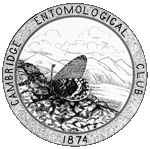
| January 2008: Psyche has a new publisher, Hindawi Publishing, and is accepting submissions |
Article beginning on page 3.
Psyche 1:3, 1874.
Full text (searchable PDF)
Durable link: http://psyche.entclub.org/1/1-003.html
The following unprocessed text is extracted from the PDF file, and is likely to be both incomplete and full of errors. Please consult the PDF file for the complete article.
7. Megisto Eurytua.- The little wood Satyr. Gosse named it the dusky Argus, but it is not an Argus. 8. Megisto Phocion.- The Georgian Satyr. In allusion to the place from which it was first described, and whence only it was for a long while known.
6'. S. Scudder:
BIBLIOGRAPHICAL RECORD.
In this Record we shall Indicate by an asterisk (*) that the correctness of the title which is given has been verified by our own examination. In the beginning, at least, it will not be practicable to observe a chron- ological order, but the contents of one periodical after another will be brought up to date, and separate works will be noticed as they are met with. B. Pickman Mann.
The Proceedings of the Boston Society of Natural History, voL xvi, as far as p. 208, contain the following entomological matter :
Statement of work done on the Society's collections of Insects, crus- tacea, &c., during the past year. p. 7, 8. * 1. A. S, PACKARD, Jr., M. D.
Catalogue of the Pha-
laenidse of California. No. 2. p. 13 - 40, with a photographic plate (i) of twenty-five figures.
Characterizes the fauna of California (Including Oregon and Nevada); compares this with the fauna of Europe, north-eastern Asia, and north- eastern America; attempts to account for the relations of the fauna. De- scribes four new genera and twenty-six new species ; also one new species from New York and one from Panama; enumerates thirty-four species. * 2. A. S. PACKAED. Occurrence of Rare and New Myr- iapods in Massachusetts. p. 111.
Swlopewlrella Americana Pack.; its bearing upon the relation of the Myriapods and Hexapods. Polyxenus faaciculatus Say. * 3. S. H. SCUDDER. Verbal communications upon a por- trait of John Abbot, a collection of orthopterological illustra- tions, and an English fossil insect of doubtful determination. p. 112. Upon a collection of Abbot's drawings, p. 117.. * 4. S. H. SCUDDER. Examination of some recent remarks by Mr. Meldola upon IpJiiclides Ajax (Papilio Ajax Auct.) p. 117 - 119.
Correction of the conclusions arrived at by Mr. M. in the Ann. and Mag. Nat. Hist., xii, 801 - 807, regarding the applicability of the case of the dif- fereut broods of I. &m to exemplify the amount of substance-waste un- dergone by insects in the pupal state,
================================================================================
* 5. S. H. SCUDDER. On the food-plant (sedges) and habits of (Eneig semidea; on the habits of (E. Aello. p. 119.
* 6. A. S. PACKARD. On the transformations of the com- mon house fly, with notes on allied forms. p. 136 - 150,
with a triple plate (iii) of embryological and transitional de- tails.
Musca domestics, Calliphora vomitoria, Surcophaga carnaria, Stomoxys calcitrans.
* 7. B. PICKMAN MANX Description of a monstrous fe- male imago of Anisopteryx pornetaria, with remarks on the pupa. p. 163 - 165.
"Female with aborted wings and pectinated antennae ; female pupae have wing-cases, but no wings.
Interesting Capture.
ON April 19 I took at Hyde Park a hibernated specimen of Nymphalis Milberti Godt. This species, common as it is in the northern part of New England, is extremely rare near Boston, which seems to be very near its southern limit, al- though single specimens have been recorded as taken as far south as Long Island and Philadelphia. I know of but one specimen having been observed in Connecticut, but in Massa- chusetts, west of Boston, several have been taken at Spring- field, Williamstown, and other localities. As we go north it becomes very abundant, and in New Hampshire, Canada, and northern New York, it is one of the commonest species. I have caught at Binghamton, N. Y., as many as twenty-five or thirty specimens in the course of an hour. H. K Morrisofi.. HENTZ'S SPIDERS.- The papers on Araneldse of the United States, pub- lished many years ago in the Boston Journal of Natural History and else- where, are to be collected and reprinted in a single volume by the Boston Society of Natural History, and edited by the Secretary, Mr. Edward Burgess. The work will be published in June, and will contain about one hundred pages and nineteen plates, including two new plates, mostly of structural details, by Emerton, and all the old ones, either from the orlginal copperplates or heliotype reproductions. Mr. Emerton will also contribute notes upon the species.
3. Pickman Mann.
================================================================================
Volume 1 table of contents